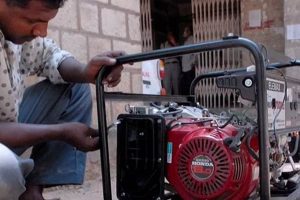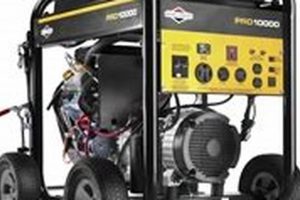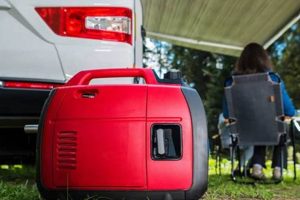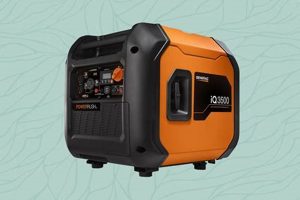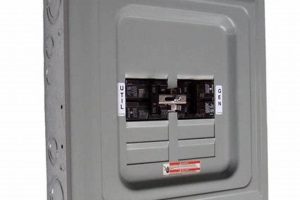Preparing a backup power source for cold weather involves specific steps to ensure reliable operation in freezing temperatures. This preparation typically includes using a cold-weather rated lubricant, adding a fuel stabilizer to prevent gasoline from freezing, and possibly employing a battery warmer. For example, ensuring the generator’s oil viscosity is appropriate for sub-zero temperatures is critical for smooth engine starting and operation.
Taking these precautionary measures offers significant advantages. A properly prepared unit can provide essential power during winter storms for critical systems like heating, lighting, and medical devices. Historically, reliance on these units for emergency power has increased, underscoring the importance of proper maintenance and preparation for various weather conditions. Protecting the investment a generator represents and guaranteeing its readiness when needed most makes this process indispensable.
This discussion will explore the crucial steps involved in cold-weather preparation, including detailed instructions for each step, recommended products, and common troubleshooting tips for optimal performance.
Winterizing Tips for Portable Generators
Proper preparation ensures reliable generator operation during cold weather. Neglecting these steps can lead to starting difficulties, malfunctions, and potential damage.
Tip 1: Use Cold-Weather Lubricant: Engine oil thickens in low temperatures, making starting difficult. Switching to an oil specifically designed for winter use, with the correct viscosity grade as recommended in the owner’s manual, ensures smooth operation.
Tip 2: Add Fuel Stabilizer: Prevent fuel from gelling or freezing by adding a fuel stabilizer. This additive helps maintain fuel quality and prevents issues with the carburetor.
Tip 3: Consider a Battery Warmer: Cold temperatures can significantly reduce battery performance. A battery warmer, or keeping the battery indoors when not in use, helps ensure reliable starting.
Tip 4: Protect from the Elements: While operating the generator outdoors is necessary for ventilation, providing a cover or shelter can protect it from snow and ice accumulation, which can impede airflow and cause malfunctions.
Tip 5: Inspect Regularly: Before and after each use during winter, inspect the unit for any signs of wear or damage. Pay particular attention to fuel lines, air filters, and spark plugs.
Tip 6: Proper Storage When Not in Use: When not in use for extended periods, drain the fuel system completely to prevent stale fuel issues. Store the unit in a dry, protected location.
Following these tips ensures reliable generator operation when it’s needed most, providing essential power during challenging winter conditions.
By taking these precautions, one can be confident in the generator’s performance, ensuring safety and peace of mind throughout the colder months. This final section will summarize key preparation steps and offer additional resources for maintaining a portable generator.
1. Oil Viscosity
Oil viscosity plays a critical role in the proper functioning of a portable generator, particularly during winter. Low temperatures significantly affect oil thickness, potentially hindering engine startup and lubrication. Selecting the correct oil viscosity is crucial for preparing a portable generator for winter conditions.
- Viscosity and Temperature
Viscosity refers to a fluid’s resistance to flow. Lower temperatures increase oil viscosity, making it thicker. A portable generator operating in freezing temperatures requires oil with a lower viscosity rating (e.g., 5W-30) to ensure it flows freely and lubricates engine components effectively. Using an oil with an excessively high viscosity in cold weather can strain the engine and hinder starting.
- Engine Protection
Correct oil viscosity is essential for protecting the engine. Adequate lubrication prevents friction and wear on engine parts during operation. Insufficient lubrication due to thickened oil can lead to premature engine damage. Specifically, during cold starts, oil with the correct viscosity reaches critical engine components quickly, minimizing wear during the initial startup phase.
- Starting Performance
Thickened oil due to low temperatures makes it harder for the engine to turn over. Using a lower viscosity oil formulated for cold weather ensures easier starting and reduces strain on the starter motor. This becomes especially crucial in emergency situations when relying on the generator for essential power. For instance, during a power outage caused by a winter storm, a generator with the correct oil viscosity will start reliably, providing necessary power for heating and other critical needs.
- Oil Selection and Generator Manuals
Consulting the generator’s owner’s manual is paramount for determining the recommended oil viscosity. Manufacturers provide specific guidelines based on the engine type and anticipated operating temperature range. Using an incorrect oil viscosity, even if intended for winter use in other applications, may not be suitable for the specific generator model and could lead to performance issues or damage.
Understanding the relationship between oil viscosity and ambient temperature is essential for effectively winterizing a portable generator. Choosing the correct oil viscosity, as specified in the owner’s manual, ensures reliable starting, protects the engine, and maximizes the generator’s lifespan during cold-weather operation. Failure to use the correct oil can lead to significant problems, especially during critical power outages in winter.
2. Fuel Stabilizer
Fuel stabilizer plays a vital role in winterizing a portable generator. Gasoline, particularly ethanol-blended fuels, can degrade and form gums and varnish during storage, especially in fluctuating temperatures. In winter, this degradation can be exacerbated by condensation forming inside the fuel tank due to temperature differences. These gums and varnish can clog fuel lines, carburetors, and fuel injectors, leading to starting difficulties or complete generator failure. Fuel stabilizer prevents this degradation by inhibiting oxidation and preventing the formation of these harmful deposits. This is crucial for ensuring the generator starts reliably when needed, especially during a winter storm power outage.
Consider a scenario where a homeowner relies on a portable generator for backup power during winter. Without fuel stabilizer, the gasoline stored in the generator could degrade over several weeks or months of inactivity. When a power outage occurs, the generator may fail to start due to a clogged fuel system. The consequences could be severe, especially in freezing temperatures where heating and other essential services depend on the generator. Conversely, using a fuel stabilizer helps maintain fuel quality, ensuring the generator starts reliably and provides the necessary power during an emergency. For instance, during a prolonged power outage, a generator with stabilized fuel can provide continuous power for essential appliances, preventing pipes from freezing and ensuring the safety and comfort of occupants.
Using fuel stabilizer is a crucial step in winterizing a portable generator. It safeguards the fuel system, prevents costly repairs, and ensures reliable operation when needed most. This proactive measure mitigates the risk of fuel-related issues, providing peace of mind and essential power during challenging winter conditions. Neglecting this step can lead to significant inconvenience and potential safety hazards during power outages. Understanding the importance of fuel stabilizer contributes to responsible generator ownership and ensures preparedness for winter emergencies.
3. Battery Maintenance
Battery maintenance is a critical aspect of winterizing a portable generator. Cold temperatures significantly reduce battery performance, making starting difficult or even impossible. Proper battery care ensures reliable generator operation when it’s needed most, especially during winter power outages.
- Temperature Effects on Battery Performance
Cold temperatures reduce a battery’s cranking power, the amperage it can deliver to start an engine. A weakened battery struggles to turn over a cold engine, which requires more power to start due to thickened oil and other factors. For example, a battery that performs adequately in warm weather might fail to start a generator in freezing conditions.
- Battery Charging and Maintenance Practices
Maintaining a full battery charge is crucial during winter. A fully charged battery is less susceptible to freezing and retains more cranking power in cold temperatures. Regularly checking the battery’s charge level and using a trickle charger to maintain a full charge, especially during periods of inactivity, can significantly improve cold-weather starting reliability. Using a battery maintainer prevents overcharging while keeping the battery at its optimal charge level.
- Battery Storage and Warmers
Removing the battery and storing it in a warm, dry location during extended periods of generator inactivity is a best practice. This protects the battery from extreme cold and prolongs its lifespan. Alternatively, using a battery warmer can help maintain battery temperature and improve cold-weather starting performance. Battery warmers are particularly beneficial in extremely cold climates.
- Battery Testing and Replacement
Periodically testing the battery’s health, especially before the onset of winter, is essential. A load test can determine the battery’s cranking power and overall condition. If the battery shows signs of weakness, replacing it before winter ensures reliable generator operation during emergencies. Ignoring battery health can lead to generator failure during critical power outages.
Proper battery maintenance is essential for reliable generator operation in winter. By understanding the effects of cold temperatures on battery performance and implementing appropriate maintenance practices, generator owners can ensure their equipment starts reliably when needed, providing crucial power during winter storms and other emergencies. Neglecting battery maintenance can compromise generator functionality precisely when it’s most needed.
4. Shelter and Ventilation
Protecting a portable generator from harsh winter elements while ensuring adequate ventilation is crucial for safe and efficient operation. Balancing these two seemingly contradictory requirements is essential for maximizing the generator’s lifespan and preventing potentially hazardous situations.
- Protection from Elements
Winter weather, including snow, ice, and freezing rain, can damage a generator’s components. A shelter protects the generator from these elements, preventing corrosion, electrical shorts, and other malfunctions. For example, a purpose-built generator cover or a temporary shelter constructed from tarpaulins or plywood can shield the unit from precipitation and wind. Without adequate protection, exposure to the elements can shorten the generator’s lifespan and lead to costly repairs.
- Ventilation Requirements
Portable generators produce carbon monoxide, a colorless, odorless, and poisonous gas. Adequate ventilation is essential to prevent carbon monoxide buildup, which can be fatal. Any shelter used must allow for sufficient airflow to dissipate exhaust fumes. Never operate a generator indoors, in a garage, or in any enclosed space. Even with a shelter, ensuring proper airflow around the generator is paramount for safety. For instance, partially enclosing a generator with a tarp while leaving ample openings on opposing sides allows for cross-ventilation and prevents dangerous gas accumulation.
- Shelter Design and Placement
Careful consideration must be given to shelter design and placement. The shelter should be positioned to allow for prevailing winds to carry exhaust fumes away from occupied areas. It should also be sturdy enough to withstand winter winds and snow loads. Improper shelter design can exacerbate carbon monoxide buildup or create a fire hazard if flammable materials are used too close to the exhaust. Shelters should not restrict access for refueling or maintenance.
- Clearance and Airflow Considerations
Maintaining adequate clearance around the generator, even with a shelter, is critical. The owner’s manual specifies minimum clearances for safe operation. Obstructions, including snowdrifts, can restrict airflow and impede proper cooling, potentially leading to overheating and damage. Regularly clearing snow and ice from around the generator and ensuring the shelter does not impede airflow is crucial for safe and efficient operation.
Balancing the need for shelter with adequate ventilation is a key aspect of winterizing a portable generator. Proper shelter design, placement, and adherence to manufacturer guidelines regarding clearances ensure safe and reliable generator operation during challenging winter conditions. Failure to address these considerations can create hazardous situations and compromise the generator’s functionality when it’s needed most. A well-designed shelter protects the generator from the elements while ensuring proper ventilation for safe and efficient operation, maximizing its lifespan and ensuring reliable power during winter outages.
5. Regular Inspections
Regular inspections constitute a critical component of winterizing a portable generator, directly impacting its reliability and longevity during cold-weather operation. These inspections serve as a preventative measure, identifying potential issues before they escalate into significant problems, particularly under the demanding conditions of winter use. Cause and effect relationships exist between neglected inspections and generator malfunctions. For instance, accumulated debris within the air intake, often exacerbated by winter conditions, can restrict airflow, leading to reduced engine efficiency and potential overheating. Similarly, undetected fuel line cracks, worsened by freezing temperatures, can cause fuel leaks, posing fire hazards and operational failures. Regular inspections mitigate these risks by facilitating early detection and timely intervention.
Consider a scenario where a generator sits idle for an extended period before a winter storm. Without regular inspections, a frayed starter cord, weakened by weathering, might go unnoticed. When the power outage hits, the generator fails to start, leaving the homeowner without heat or light. Conversely, regular checks would have identified the worn cord, allowing for replacement before it became critical. Practical significance derives from understanding that regular inspections not only identify existing issues but also prevent future problems. Inspecting spark plugs for fouling and replacing them as needed ensures efficient combustion, crucial for reliable operation in freezing temperatures. Verifying proper oil levels prevents engine damage caused by insufficient lubrication, particularly relevant with the increased viscosity of oil in cold weather.
Regular inspections represent a cornerstone of responsible generator ownership, particularly crucial during winter. They offer a proactive approach to maintenance, minimizing the risk of unexpected failures during critical periods. This proactive maintenance approach not only ensures reliable generator operation when needed most but also extends the lifespan of the investment, ultimately proving more cost-effective than reactive repairs following a breakdown. Integrating regular inspections into a winterization routine establishes a foundation for safe and dependable generator performance throughout the colder months.
6. Proper Storage
Proper storage is integral to winterizing a portable generator, ensuring its longevity and reliable operation when needed. Failing to store a generator correctly during periods of inactivity, especially over winter, can lead to fuel system issues, corrosion, and starting difficulties. Appropriate storage safeguards the generator against these potential problems, preserving its functionality and extending its lifespan. This practice contributes significantly to the overall effectiveness of the winterization process, ensuring the generator remains in optimal condition for use when required.
- Fuel System Preservation
Storing a generator with fuel in the system for extended periods, particularly over winter, invites fuel degradation. Gasoline, especially ethanol blends, can oxidize and form gums and varnish, clogging carburetors and fuel lines. Draining the fuel system completely before storage mitigates this risk, preserving the integrity of fuel system components and ensuring smooth starting when the generator is needed. For example, a generator stored with untreated fuel over winter might experience starting difficulties or even fuel system failure in the spring. Draining the fuel prevents such issues.
- Corrosion Prevention
Winter’s fluctuating temperatures and humidity levels create an environment conducive to corrosion. Moisture accumulation within the generator, especially in the fuel tank and engine components, can lead to rust and other forms of corrosion, compromising the generator’s structural integrity and functionality. Proper storage in a dry, ventilated area mitigates this risk. Using a desiccant inside the storage area can further absorb moisture, providing additional protection against corrosion. A generator stored in a damp environment without proper precautions might require costly repairs or even replacement due to corrosion damage.
- Battery Preservation
Cold temperatures significantly impact battery performance and lifespan. Storing a generator with the battery connected can lead to battery discharge and potential freezing. Disconnecting and removing the battery before storage, and storing it in a cool, dry place, safeguards against these issues. Using a battery tender during storage maintains the batterys charge, further enhancing its lifespan and ensuring it’s ready for use when needed. Failing to address battery storage properly can result in a dead battery or reduced starting power when the generator is required.
- Starting Reliability
Proper storage directly impacts the generator’s starting reliability after a period of inactivity. By addressing fuel system preservation, corrosion prevention, and battery maintenance, proper storage ensures all components are in optimal condition for starting. This is particularly crucial during winter emergencies when reliable power is essential. A properly stored generator starts readily when needed, providing critical power for heating, lighting, and other essential appliances during a winter storm.
Proper storage practices are essential for preserving the generator’s condition and ensuring its reliable operation when needed, especially during winter. By mitigating the risks of fuel degradation, corrosion, and battery failure, proper storage contributes significantly to the overall effectiveness of winterizing a portable generator. This, in turn, provides peace of mind and ensures access to backup power during critical winter outages. Neglecting proper storage compromises the generator’s readiness and jeopardizes its ability to provide essential power when it matters most.
7. Load Management
Load management is an essential operational consideration for portable generators, particularly during winter. Effective load management optimizes generator performance, extends its lifespan, and ensures critical systems receive power during outages. Winter conditions often increase reliance on generators for heating and other essential needs, making load management crucial for safe and efficient operation.
- Prioritization of Essential Loads
During a winter power outage, prioritizing essential loads ensures critical systems remain operational. Essential loads typically include heating systems, refrigerators, lighting, and medical equipment. Non-essential loads, such as entertainment systems and non-essential appliances, should be disconnected to avoid overloading the generator. For example, during a blizzard, prioritizing the furnace over a television ensures continued warmth and safety. This prioritization maximizes the generator’s capacity to power critical systems, preventing overload and potential damage.
- Load Calculation and Generator Capacity
Understanding the wattage requirements of connected appliances is crucial for effective load management. Adding the wattage of all intended loads ensures the total does not exceed the generator’s rated capacity. Exceeding the generator’s capacity leads to overloading, potentially causing damage to both the generator and connected appliances. For instance, attempting to run a space heater, refrigerator, and sump pump simultaneously on a generator with insufficient capacity can lead to overload and system failure. Calculating load requirements before connecting appliances prevents such scenarios.
- Staggered Startup and Load Distribution
Staggering the startup of appliances helps prevent sudden power surges that can overload the generator. Starting large appliances one at a time allows the generator to adjust to the increasing load, minimizing strain. Distributing loads evenly across available outlets also prevents overloading individual circuits and ensures balanced power delivery. For example, connecting a space heater to one outlet and a refrigerator to another, rather than both to the same outlet, distributes the load effectively. This practice optimizes generator performance and prevents circuit overload.
- Regular Monitoring and Adjustment
Regularly monitoring the generator’s load during operation allows for adjustments based on changing needs. Observing the generator’s output meter and listening for signs of strain, such as a change in engine speed, helps identify potential overload situations. Adjusting connected loads as needed, such as turning off non-essential appliances during peak demand, ensures the generator operates within its safe operating range. This ongoing monitoring and adjustment optimizes performance and prevents potential damage from overload.
Effective load management is integral to safe and efficient generator operation, especially during winter. By prioritizing essential loads, calculating load requirements, staggering startup, and regularly monitoring generator performance, users can maximize the generator’s effectiveness and ensure critical systems remain powered during outages. This careful management not only protects the generator from damage but also ensures reliable power delivery when it’s needed most, contributing to safety and comfort during winter weather events. Integrating these load management strategies into winter preparedness planning enhances the overall effectiveness of generator utilization during challenging conditions.
Frequently Asked Questions about Winterizing Portable Generators
This section addresses common inquiries regarding the preparation and maintenance of portable generators for winter operation. Understanding these aspects is crucial for ensuring reliable performance and maximizing the lifespan of the equipment.
Question 1: Why is it necessary to change the oil viscosity for winter operation?
Lower temperatures increase oil viscosity, making it thicker and less effective at lubricating engine components. Using a lower viscosity oil specifically designed for cold weather ensures proper lubrication and easier starting in freezing conditions.
Question 2: What type of fuel stabilizer is recommended for winter use?
A fuel stabilizer specifically formulated for ethanol-blended gasoline is recommended. This type of stabilizer prevents fuel oxidation, gum formation, and phase separation, which can occur in cold temperatures and lead to fuel system issues. Consult the generator’s owner’s manual for specific recommendations.
Question 3: How can one prevent a generator battery from freezing during winter?
Maintaining a full battery charge is the primary defense against freezing. A fully charged battery has a lower freezing point. Using a battery warmer or disconnecting and storing the battery indoors during extended periods of inactivity provides additional protection. Regularly checking the battery’s charge level and using a trickle charger as needed ensures proper charging maintenance.
Question 4: Is it safe to operate a portable generator under a cover during winter?
Operating a generator under a cover is permissible only if the cover is specifically designed for generator use and allows for adequate ventilation. Improper ventilation can lead to dangerous carbon monoxide buildup. Never operate a generator indoors or in any enclosed space, even with a cover. Ensure the cover does not obstruct airflow around the generator.
Question 5: How often should a portable generator be inspected during winter?
Regular inspections, ideally before and after each use, are recommended during winter. These inspections should include checking the oil level, fuel level, battery charge, and overall condition of the generator. Look for any signs of wear, damage, or leaks. More frequent inspections may be necessary in harsh winter conditions.
Question 6: What is the best way to store a portable generator during the winter months if it’s not being used?
For long-term winter storage, drain the fuel system completely to prevent fuel degradation. Disconnect and remove the battery, storing it in a cool, dry place. Clean the generator thoroughly and store it in a dry, ventilated area, preferably covered. These steps protect the generator from corrosion and ensure it remains in optimal condition for future use.
Proper generator maintenance and preparation for winter operation ensure reliable performance during critical power outages. Consulting the owner’s manual for specific model guidelines and recommendations is essential for optimal performance and safety.
The next section will offer a troubleshooting guide for common issues encountered during winter generator operation.
Winterizing Portable Generators
Preparing portable generators for winter involves crucial steps that ensure reliable operation during inclement weather. This comprehensive guide has explored essential aspects, including oil viscosity adjustments for optimal lubrication in low temperatures, fuel stabilization to prevent degradation and ensure consistent combustion, and battery maintenance to guarantee reliable starting. Furthermore, the importance of providing adequate shelter while maintaining proper ventilation, conducting regular inspections to identify potential issues, and implementing appropriate storage procedures to safeguard against corrosion and other damage has been emphasized. Load management strategies, crucial for optimizing generator performance and preventing overload during peak demand, have also been detailed. Each of these elements contributes significantly to the overall effectiveness of winterizing a portable generator, ensuring reliable power during critical winter outages.
Reliable access to backup power during winter storms and other emergencies underscores the significance of proper generator preparation. Investing time and effort in these preventative measures safeguards not only the generator itself but also the well-being of those who rely on it. Thorough preparation mitigates the risks associated with winter power outages, providing peace of mind and ensuring essential systems remain operational during challenging conditions. Proactive generator maintenance is an investment in safety and preparedness, contributing significantly to resilience during unpredictable winter weather.

